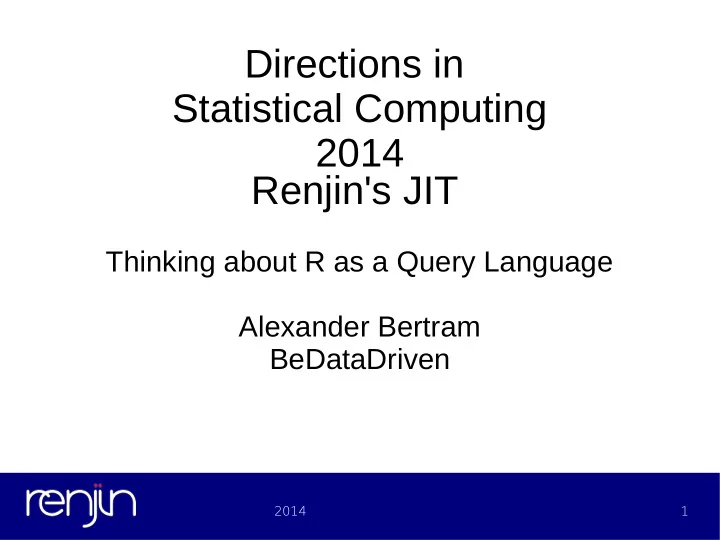

Directions in Statistical Computing 2014 Renjin's JIT Thinking about R as a Query Language Alexander Bertram BeDataDriven 2014 1
Quick Intro: Renjin ● R-language Interpreter written in Java, uses GNU R core packages (base, stats, etc) as-is ● Goals: Completeness first, performance next ● C/Fortran: Supported with translator and emulation layer ● Can run roughly ~50% of CRAN packages (see packages.renjin.org) ● Actively user group, diverse 2014 2
R as a “Query Language” How can R be as fast as Fortran or C++ ? How can R be more like SQL? – Analyst describes the what – Query planner determines the how ● Implicit parallelism ● Target diverse architechture (in-memory, single node, clusters) 2014 3
Is R dynamic? Argument: Not where/when performance matters 2014 4
“But R is too dynamic!” airlines <- read.bigtable(“airlines”) Complicated print(nrow(airlines)) # ~240m Argument Matching fit.exp <- function(x, max.iter = 10 ) { rate <- 1 / mean(x) repeat { loglik <- sum (-dexp(r = rate, x = lambda, log = T) if( goodEnough(loglik) ) break rate <- next } } sum() is group Is the break() generic, function dispatches based redefined? on argument 2014 5
airlines <- read.bigtable(“airlines”) delay <- airlines$delay[airlines$ delay > 30] dexp <- function ( x , rate=1, log = FALSE) { mean <- 1/rate d <- exp(- x / mean ) / mean if(log) return(log( d )) d } fit.exp <- function ( x , max.iter = 10 ) { rate <- 1 / mean( x ) repeat { loglik <- sum(-dexp(r = rate , x , log = T) if( logLik > epsilon ) break rate <- update(rate) } } rate <- fit.exp 2014 6
Real world example: Distance Correlation [ see energy package] 2014 7
2014 8
Optimizations: Views x <- dist(x) y <- dist(y) x <- as.matrix(x) y <- as.matrix(y) # GNU R: x^2 + y^2 memory alloc'd # Renjin: ~ 0 2014 9
DistanceMatrix public class DistanceMatrix extends DoubleVector { private Vector vector; public double getElementAsDouble(int index) { int size = vector.length(); int row = index % size; int col = index / size; if(row == col) { return 0; } else { double x = vector.getElementAsDouble(row); double y = vector.getElementAsDouble(col); return Math.abs(x - y); } } public int length() { return vector.length() * vector.length(); } } 2014 10
Deferred Evalution ● Defer computation of pure functions when inputs exceed some threshold: x <- (1:100) + 4 # x is computed y <- (1:e^6) + 4 # no work done # x is a view z <- y – mean(z) z <- dnorm(z) print(z) # triggers evaluation 2014 11
2014 12
Query Planner ● Once evaluation is triggered: we have a better broad view of the calcuation to be completed ● Computation Graph is essentially a pure function ● We can reorder operations, and easily see which branches can be evaluated independently, in parallel 2014 13
2014 14
Loop Fusion mean(op1(op2(op3(x))) transformed to... double sum = 0; for(int i..1000) { sum += op1(op2(op3)) } 2014 15
Beyond Bytecode JVM Byte Code → JVM Byte Code → Native Machine Code Native Machine Code SQL Query OpenCL 2014 16
Results 2014 17
2014 18
Loops! m <- 4 for (i in 1:m) { x = exp (tanh (a^2 * (b^2 + i/m))) r[i%%10+1] = r[i%%10+1] + sum(x) } Kaboom! (thanks Radford!) 2014 19
Loops! ● R gives you the flexibility to mix imperative with functional approaches ● In many dynamic languages (JS, Ruby), sophisticated runtime analysis is required to identify and compile hotspots in the code. ● In R, they're pretty easy to spot: x <- 1:1e6 for(i in seq_along(x)) { ... } 2014 20
for (i in 1:m) { x = exp (tanh (a^2 * (b^2 + i/m))) r[i%%10+1] = r[i%%10+1] + sum(x) } BB4: [L2] BB3: [L1] ₃ ₂ Λ0 ← increment counter Λ0 ₂ ₃ ₂ i ← τ [Λ0 ] BB1: goto L0 ₄ ₀ ₃ ₀ τ ← (^ a 2.0d) τ ← (: 1.0d m ) ₅ ₀ τ ← (^ b 2.0d) Λ0 ← 0 ₁ τ ← (/ i m ) ₆ ₂ ₀ BB5: [L3] τ ← length(τ ) ₂ ₃ τ ← (+ τ τ ) ₇ ₅ ₆ return NULL τ ← (* τ τ ) ₈ ₄ ₇ BB2: [L0] ₉ ₈ τ ← (tanh τ ) r ← Φ(r , r ) ₁ ₀ ₂ ₂ ₉ x ← (exp τ ) ₂ ₁ ₃ Λ0 ← Φ(Λ0 , Λ0 ) ₁₀ ₂ τ ← (%% i 10.0d) ₁ ₀ ₂ i ← Φ(i , i ) ₁₁ ₁₀ τ ← (+ τ 1.0d) ₁ ₀ ₂ x ← Φ(x , x ) τ ← ([ r τ ) ₁₂ ₁ ₁₁ if Λ0 >= τ => TRUE:L3, ₂ ₂ τ ← (sum x ) ₁₃ ₂ FALSE:L1, NA:ERROR τ ← (%% i 10.0d) ₁₄ ₂ ₁₅ ₁₄ τ ← (+ τ 1.0d) ₁₆ ₂ τ ← (%% i 10.0d) ₁₇ ₁₆ τ ← (+ τ 1.0d) r ← ([<- r τ ) ₂ ₁ ₁₇ 2014 21
Compared to other dynamic languages? ● Argument: Speculative specialization works very well for long-running code, but unnecessary for most statistical code with many loops: – Simulations – Iterative algorithms – ? ● Needs to be tested... 2014 22
packages.renjin.org 2014 23
Developing CI + benchmarking system for testing optimizations 2014 24
More Information ● http://www.renjin.org ● http://packages.renjin.org ● http://docs.renjin.org/en/latest/ 2014 25
Recommend
More recommend